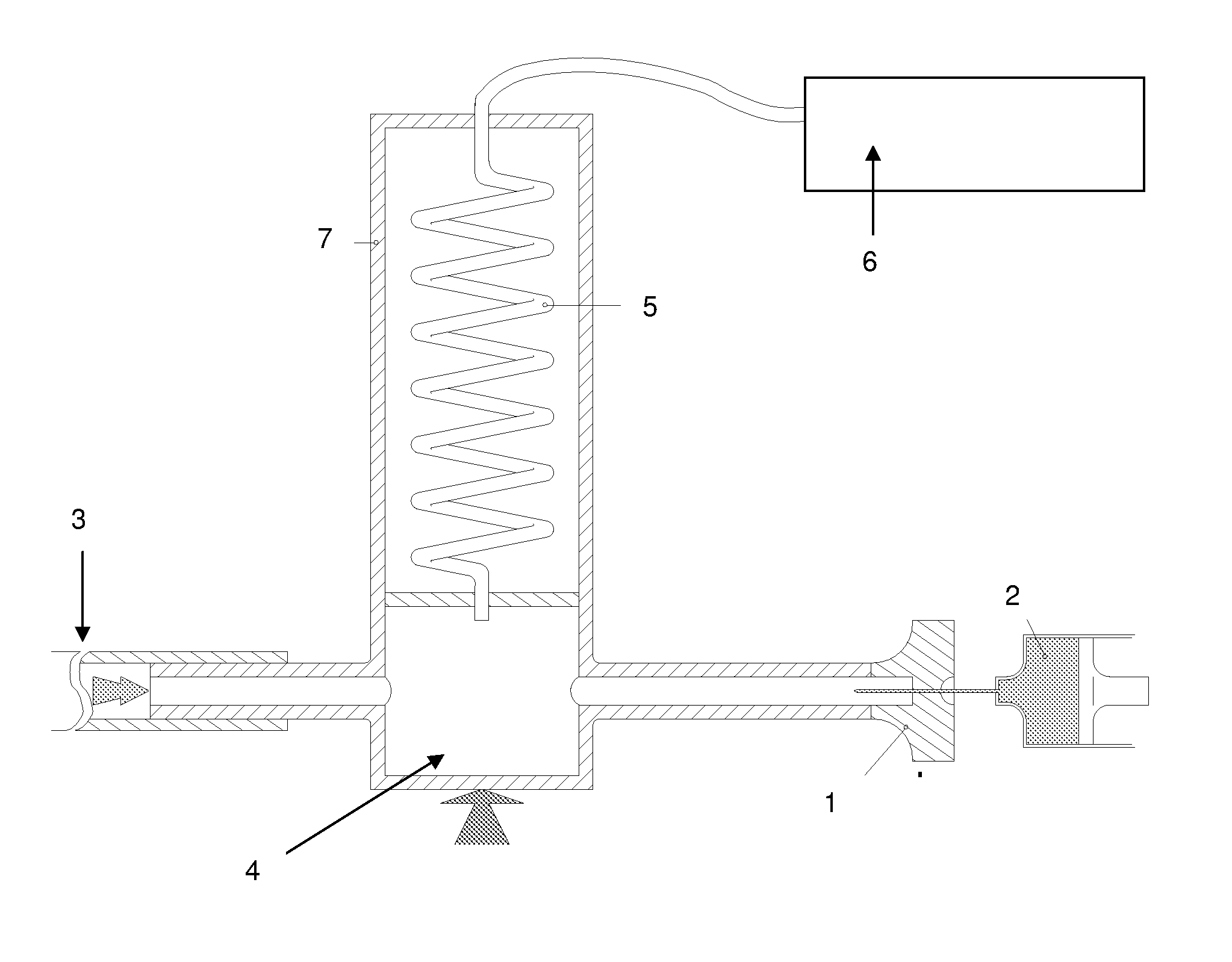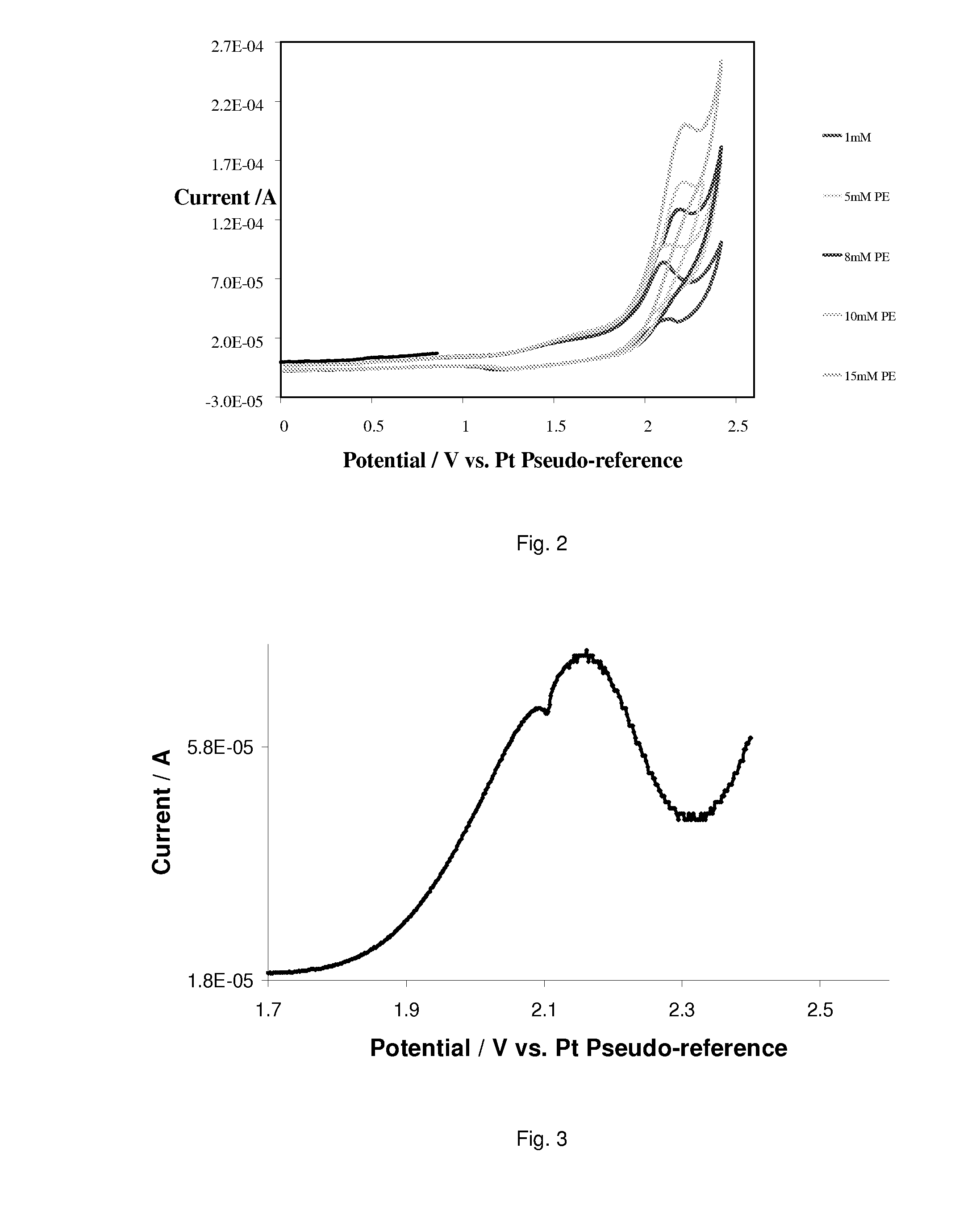Detection of Chiral Alcohols and Other Analytes
- Summary
- Abstract
- Description
- Claims
- Application Information
AI Technical Summary
Benefits of technology
Problems solved by technology
Method used
Image
Examples
example 1
Detection of 1-phenylethanol by Direct Oxidation
Experimental
[0058]A solution containing 95% acetonitrile to 5% water (v / v) was prepared. This was used to prepare a solution (250 cm3) containing a NaClO4 (0.2 M) supporting electrolyte. This was used as the ‘solvent’ for all solutions detailed in this section. Three BG solutions (10 cm3) were made up and characterized by CV and SWV (0-2.4 V, at 100 mV / s). These contained ‘solvent’, TEMPO (0.15 mM); and TEMPO (0.15 mM), 2,6-lutidine (0.02 M)
[0059]Solutions (10 cm3) containing TEMPO (0.15 mM), 2,6-lutidine (0.02 M), and various PE concentrations (1 mM, 5 mM, 8 mM, 10 mM and 15 mM) were then made up. These solutions were characterized by CV (between 0 V and 2.4 V, at 10 mV / s, 25 mV / s, 50 mV / s, 100 mV / s, 200 mV / s, 300 mV / s and 500 mV / s) and SWV (0-2.4V, at 100 mV / s). The pH of these solutions was measured with a pH electrode (Mettler Toledo, model Seven Multi). The average pH was 8.7. The following control solutions were made and characte...
example 2
Resolution of 1-phenylethanol by Direct Oxidation in the Presence of a Chiral Base ((−)-Sparteine)
Experimental
[0069]Both an aqueous (with a 1 M KCl supporting electrolyte) and non-aqueous (acetonitrile, with 0.2 M NaClO4 supporting electrolyte) solvent were investigated. In the acetonitrile tests, BG CVs (between 0V and 2.5 V, at 50 mV / s) and SWVs (0-2.6 V, at 100 mV / s) were recorded on solutions (10 cm3) containing:[0070]a. NaClO4 (0.2 M), and TEMPO (0.15 mM)[0071]b. NaClO4 (0.2 M), TEMPO (0.15 mM) and (−)-sparteine (0.02 M)
[0072]Solutions (10 cm3) containing TEMPO (0.15 mM), (−)-sparteine (0.02 M), NaClO4 (0.2 M) and S- or R-PE (0.01 M) were prepared and characterized by CV (between 0 V and 2.6 V, at 50 mV / s) and SWV (0-2.6 V, at 100 mV / s). A GCE WE, Pt flag auxiliary electrode and a Pt wire pseudo-reference electrode were used.
[0073]In the aqueous tests, solutions (10 cm3) containing TEMPO (0.1 mM), (−)-sparteine sulphate (0.04 M) and S- or R-PE (0.02 M) were prepared and charact...
example 3
Synthesis of a Cofactor Comprising an Electron Mediator
[0075]A compound of the formula (I) was synthesised according to Scheme 1:
Conversion of (R)—N,N-Dimethyl-1-Ferrocenylethylamine to (R)-Ferrocenylethyl Acetate
[0076]The starting material, (R)—N,N-dimethyl-1-ferrocenylethylamine, was characterized by 1H NMR and ES+ mass spectrometry, to test the purity and for later comparison with the products. J values are given in Hz. Rf 0.61 (80% EtOAc: 20% hexane solvent system, silica plate), δH (200 MHz; CDCl3; Me4Si) 1.43 (3H, d, 3J 7, NCHCH3), 2.06 (6H, s, 2×NCH3), 3.60 (1H, q, 3J 7, NCH), 4.03-4.1.43 (9H, m, Fc), m / z (ES+) 258 (11% M+Na+), 213 (100, vinyl ferrocene+H+).
[0077]Two portions of (R)—N,N-dimethyl-1-ferrocenylethylamine (2×500 g) were then placed in two 10 ml tubes designed for use in a microwave. Each portion was dissolved in acetic anhydride (1.5 cm3) with stirring to ensure a complete mixing. The tubes were sealed and placed in a microwave oven (Biotage, model Initiator sixt...
PUM
 Login to View More
Login to View More Abstract
Description
Claims
Application Information
 Login to View More
Login to View More - R&D
- Intellectual Property
- Life Sciences
- Materials
- Tech Scout
- Unparalleled Data Quality
- Higher Quality Content
- 60% Fewer Hallucinations
Browse by: Latest US Patents, China's latest patents, Technical Efficacy Thesaurus, Application Domain, Technology Topic, Popular Technical Reports.
© 2025 PatSnap. All rights reserved.Legal|Privacy policy|Modern Slavery Act Transparency Statement|Sitemap|About US| Contact US: help@patsnap.com



